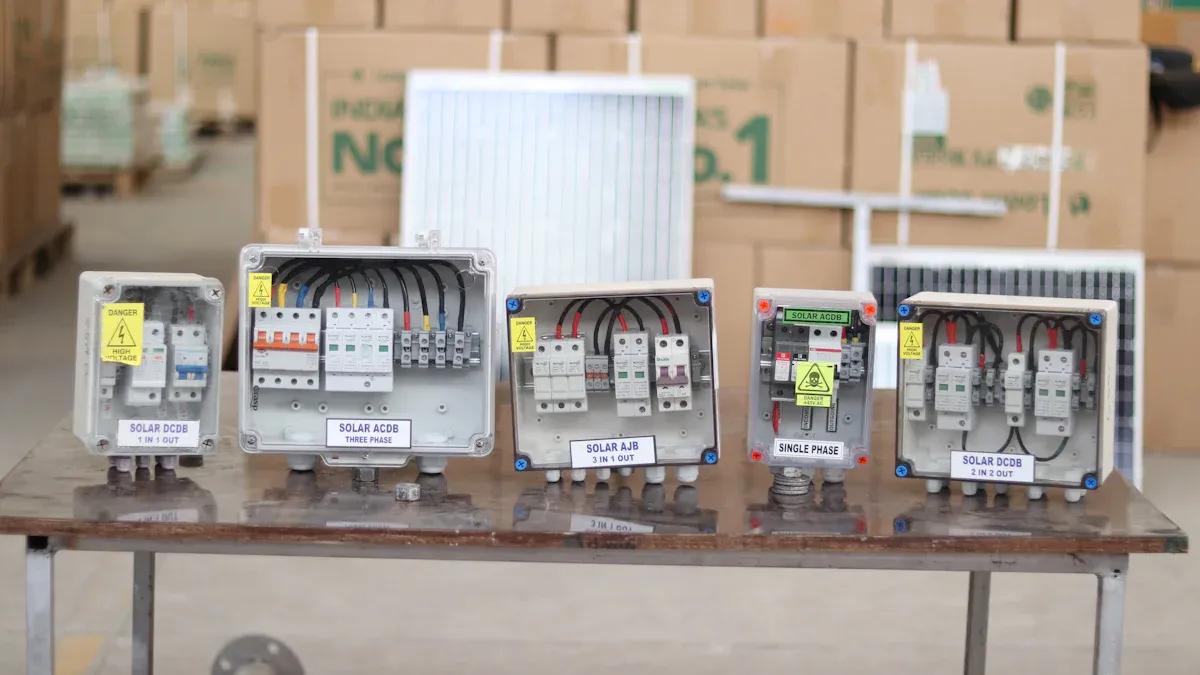Choosing between an 8-way combiner box and a 16-way combiner box depends on a few key things. You should count how many solar strings you have now. Think about if you might add more later. The voltage and current ratings must match your system. Make sure the combiner box has the right certifications and safety features. Look at the local weather and where you will put the box. Think about how easy it is to install and how much money you can spend.
- Most common factors:
- Number of input circuits
- Electrical ratings
- Quality and certification
- Protection functions
- Environmental adaptability
- Installation and maintenance
- Cost
At the end, you will know which box is best for you.
Key Takeaways
- Count your solar strings before picking a combiner box. Each string needs its own spot.
- Think about adding more later. An 8-way box is good for small systems. A 16-way box lets you add more in the future.
- Check the voltage and current ratings. Make sure the combiner box fits your system for safety.
- Look for safety features like surge protection and arc-fault protection. These help keep your system safe.
- Pick a box made from strong materials. Tough boxes last longer and protect your system from weather.
System Size
Count Strings
Start by counting your solar strings. Each string needs its own input in the combiner box. If you have six strings, you need six inputs. Add up the current from each string. For example, four strings with 9 amps each make 36 amps. Multiply this by 1.25 to check for power spikes. This helps stop overloads and keeps things safe.
Tip: Always look at the combiner box’s max current rating before you buy. This keeps your equipment safe and follows safety rules.
Match Box to Needs
Pick a combiner box that fits what you need now and later. If you have eight strings or less, use an 8-way combiner box. If you want to add more strings, get a bigger box. Experts say to choose a box with 20%–30% more inputs than you need. This makes it easier to grow and saves money later.
| Aspect | Explanation |
|---|---|
| Additional Input Ports | Extra terminals help you add more strings later. |
| Surplus Current Capacity | Pick cables and busbars for the highest load. |
| Reserved Physical Space | Leave space for new parts to avoid upgrades. |
| Cost Efficiency | Spending a little more now saves money and time later. |
When picking a combiner box, follow these tips for big solar systems:
- The right size keeps your system safe and follows rules.
- Most boxes work with 8–24 strings.
- Common voltages are 600V, 1000V, and 1500V DC.
- Each string gives 8–15 amps. The box must handle all of it.
- Output cable size should fit the amps and voltage drop.
- Pick enclosures with IP65 or higher for tough places.
- Use UV-stabilized polycarbonate or powder-coated steel for strength.
- Add surge protection made for DC systems.
If your system is small and won’t grow, pick the 8-way combiner box. If you plan to add more panels, a bigger box is better. Always check your string count, total current, and if you might expand before you choose.
8-way combiner box vs 16-way

Flexibility for Growth
When you choose between an 8-way combiner box and a 16-way combiner box, you need to think about how your solar system might change. If you have a small system now, you might want to add more solar panels later. A 16-way combiner box gives you more room to grow. You can connect more strings in the future without changing the box. This makes it easier to expand your system when you want more power.
If you pick an 8-way combiner box, you can connect up to eight strings. This works well if you do not plan to add more panels. If you want to keep your options open, a 16-way combiner box gives you extra space for new strings. You do not need to buy a new box if you expand. This saves you time and effort later.
Note: Planning for growth helps you avoid extra work and costs in the future. Think about your long-term goals before you decide.
Upgrade Considerations
Upgrading your solar system can cost more if you start with a smaller combiner box. If you use an 8-way combiner box and later want to add more than eight strings, you will need to buy a new box and pay for new wiring. This means extra labor and more downtime for your system.
A 16-way combiner box costs more at first, but it can save you money over time. You do not need to replace the box when you add more strings. You also make wiring simpler, which can lower installation costs and make maintenance easier. Here is a table that shows what you need to think about:
| Consideration | Implication |
|---|---|
| Initial Investment | Higher for a 16-way combiner box compared to smaller options. |
| Future Expansion | Ability to add more strings without replacing the combiner box, leading to savings. |
| Wiring Complexity | Reduced complexity can lower installation costs and ease maintenance. |
| Long-term Savings | Potential savings on material and installation costs over time. |
If you know your system will stay small, the 8-way combiner box is a good choice. If you think you will add more panels, the 16-way combiner box helps you avoid extra upgrades. You can plan ahead and save money in the long run.
Cost & Space
Price Comparison
When you look at prices, you see a big difference. The 8-way combiner box costs less. It has fewer input terminals and is smaller. The 16-way combiner box costs more. It can handle more strings and uses stronger materials. Most DC combiner boxes have a 5-year warranty. Solar combiner boxes often have a 1-year warranty. Always check the warranty before buying. The warranty matters for long-term value.
Materials change the price too. Here is a table with common materials:
| Material | Description |
|---|---|
| Metal | Strong, lasts in bad weather, easy to use and fix. |
| Plastic | Light, does not rust, cheap, but can fade in sunlight. |
| Fiberglass | Very strong, does not rust, light, easy to care for, good in tough weather. |
| Hybrid | Mixes good parts of materials, strong, saves money, helps the environment. |
Pick a box with materials that fit your budget and needs. Metal and fiberglass cost more but last longer. Plastic and hybrid boxes are cheaper but may need more care.
Installation Space
Think about where you will put your combiner box. The 8-way combiner box fits in homes and small shops. It needs less space and works for simple setups. The 16-way combiner box is bigger. It is made for businesses and factories. You need more room because it handles more power.
If you put a big combiner box in a small space, you may have problems:
- You need enough space to work safely and fix things.
- Where you put the box changes how well your system works. A good spot lowers power loss.
- Putting the box on a shaded wall, like a north wall, keeps it cool. This helps in small or tight places.
Measure your space before you buy. Make sure you can reach the box for wiring and repairs. Good planning stops problems and keeps your system working well.
Safety & Ratings
Voltage & Current
Check the voltage and current ratings before you buy. Every combiner box can only handle a certain voltage and current. Most solar combiner boxes work with 600V, 1000V, or 1500V DC. Match the box rating to your solar system. If your strings make a lot of current, the box must handle it. Look at the amp rating for each input and the total output. Using a box with a lower rating can cause overheating and damage.
Tip: Pick a combiner box with a higher rating than your system needs. This helps stop overloads and keeps your system safe.
Check what kind of circuit breakers and fuses are inside the box. Good boxes use DC-rated breakers and fuses. These protect your wires and equipment from short circuits and power surges. Surge protection devices help guard against lightning and spikes. If you put your box outside, look for enclosures with IP65 or IP66 ratings. These keep out dust and water.
Compliance
Make sure your combiner box meets safety standards and certifications. These rules protect your system and keep you safe. Manufacturers test boxes to meet strict guidelines. Here is a table with common standards and certifications:
| Standard/Certification | Description |
|---|---|
| IEC 61439 | Low-voltage switchgear and control gear assemblies |
| IEC 60269-6 | Fuses for photovoltaic systems |
| IEC 61643 | Surge protective devices |
| IEC 62109 | Safety of power converters for PV applications |
| IEC 60529 | Ingress protection (IP rating of enclosures) |
| UL 1741 | Inverters, combiners, and PV system equipment |
| UL 67 | Panelboards and enclosures |
| UL 508A | Industrial control panels |
| UL 489 | Molded-case circuit breakers |
| NEC 690.9 | Overcurrent protection |
| NEC 690.15 | Disconnecting means |
| NEC 690.17 | Switch ratings for DC circuits |
| NEC 705 | Interconnection to the grid |
| IP65 / IP66 | Protection against dust and water ingress |
| NEMA 3R / 4X | U.S. enclosure ratings for outdoor environments |
| UV resistance | Material testing for solar exposure |
| Salt mist corrosion resistance | IEC 60068 for coastal installations |
Look for these marks on the product label or in the manual. If your system is near the coast, pick boxes with salt mist corrosion resistance. For outdoor use, choose boxes with NEMA 3R or 4X ratings. These features help your system last longer and work safely.
Note: Certified combiner boxes help you pass inspections and keep your solar system working well. Always check for these standards before you buy.
Decision Checklist
Check this list before you pick your combiner box. It helps you choose the right size and features for your solar system.
What to Check Before You Decide
- Count Your Strings
Write down how many solar panel strings you have now. If you have more than three strings, you need a combiner box. Commercial systems usually need a bigger box because they have more strings. - Plan for Growth
Think about adding more panels later. Pick a combiner box that can take extra strings. This way, you will not need a new box if you expand. - Check Compatibility
Make sure the box works with your system’s voltage and current. Look at both input and output ratings. - Review Safety Features
Look for arc-fault protection, surge protection, and reverse current prevention. These features help keep your system safe from electrical problems. - Look for Monitoring
Choose a box that lets you check each string’s current. Some boxes also show voltage and temperature. This helps you find problems early. - Check for Local Disconnect
A local disconnect switch lets you turn off the system safely for repairs. - Assess the Enclosure Material
Pick a box made from strong materials like metal or fiberglass. This keeps your system safe from weather and damage. - Verify Compliance
Make sure the box meets NEC and IEC standards. Check for overcurrent and arc-fault protection. Certified boxes help you pass inspections.
Tip: Big systems always need a combiner box for safety and easy use. Monitoring helps you see how your system works and find problems fast.
| Feature | What to Look For |
|---|---|
| Number of Inputs | Enough for now and future strings |
| Voltage/Current Rating | Matches your system’s needs |
| Safety Mechanisms | Arc-fault, surge, reverse current |
| Monitoring | String-level current and voltage |
| Enclosure Material | Weather-resistant and strong |
| Compliance | NEC, IEC, UL certifications |
Use this checklist to compare your choices. You will feel sure about your pick and keep your solar system safe for the future.
When you choose a combiner box, you need to focus on system size, future expansion, cost, space, and safety. You should pick an 8-way box for up to eight strings. A 16-way box works best if you plan to grow your system. Industry experts suggest you look at these main points:
- Pick a box with third-party certification for safety.
- Match the enclosure type to your local climate.
- Select the right size for your number of strings.
- Install the box in a shaded spot.
- Check the box often to keep it working well.
Use the checklist before you decide. If you feel unsure, talk to a solar professional for advice.
FAQ
What is a combiner box?
A combiner box joins many solar panel strings together. It makes one output from many wires. It helps keep wires neat and safe. The box also protects the circuits. This makes your solar system safer to use.
What makes an 8-way combiner box different from a 16-way combiner box?
An 8-way combiner box connects up to eight solar strings. A 16-way combiner box lets you connect up to sixteen strings. You pick one based on how big your system is. Think about if you want to add more panels later.
What features should you look for in a combiner box?
Check if the box has enough input terminals for your needs. The enclosure should be strong and last outside. Surge protection keeps your system safe from power spikes. Safety certifications show the box is tested. Monitoring helps you see how your system works. Weather resistance is important for outdoor use.
What happens if you use a combiner box with too few inputs?
If your box does not have enough inputs, you cannot connect all your solar strings. This means your system will not make as much power. It can also make the wiring unsafe.
See also
Solar Combiner Boxes and Voltage Changes: What to Know
How to Calculate Max Strings for Solar Combiner Box
Combiner box solutions for your AC and DC needs
How to Choose the Best Combiner Box for Your Solar Project
Analysis of key components of solar photovoltaic combiner box



